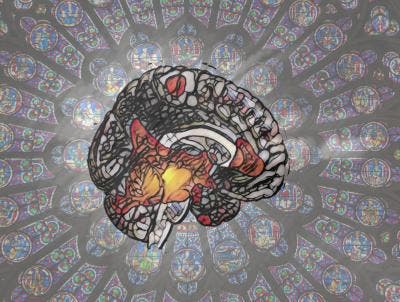Consciousness can be both a blessing and a curse. During humanity’s first steps on this planet, the world looked radically different. Mysteries were everywhere and the thought of uncertainty was ever present. It’s no wonder then that virtually every culture across different points of time and geographies have independently invented religious frameworks that soothe existential dread.
Even in modern times, more than 80% of people around the world identify themselves as either religious or spiritual. That’s because, for most people at least, spiritual beliefs may be hardwired in our brains.
During previous research, scientists performed brain scans to see which areas of the brain light up while performing a task in spiritual people versus non-spiritual ones. However, the correlative nature of such investigations is inherently limiting.
Poke the brain and you may find god
To get to the bottom of things, researchers at Brigham and Women’s Hospital in Boston, Massachusetts, took a much more radical approach to map spirituality in the brain than other groups have attempted in the past.
Michael Ferguson and colleagues employed a technique known as lesion network mapping by which complex human behaviors can be attributed to specific brain circuits based on the locations of brain lesions in patients. If a certain behavior ceases or, conversely, gets triggered by a certain lesion, then that means the corresponding brain region must be somehow involved.
The team leveraged a dataset involving 88 patients who underwent brain surgery to remove tumors that were distributed throughout the brain. The patients also completed a lengthy survey that included questions pertaining to spiritual acceptance before and after their surgery.
Of the 88 neurosurgical patients, 30 showed a decrease in self-reported spiritual belief before and after neurosurgical brain tumor resection, 29 showed an increase, and 29 showed no change.
Using the lesion network mapping technique, the researchers associated changes in spiritual beliefs with brain circuits in the periaqueductal gray (PAG), a brainstem region that has been implicated in numerous functions, including fear conditioning, pain modulation, altruistic behaviors, and unconditional love.
“Our results suggest that spirituality and religiosity are rooted in fundamental, neurobiological dynamics and deeply woven into our neuro-fabric,” said Ferguson, a principal investigator in Brigham’s Center for Brain Circuit Therapeutics. “We were astonished to find that this brain circuit for spirituality is centered in one of the most evolutionarily preserved structures in the brain.”
The results from the first dataset were validated with a second dataset involving more than 100 patients with brain lesions caused by head trauma from combat during the Vietnam war. These patients were asked questions like “Do you consider yourself a religious person? Yes or No? after suffering brain damage.
However, the fact that all participants involved in this study were from predominantly Christian cultures and the lack of robust information regarding patient upbringing are both important limitations. The researchers would have to repeat the study across many other backgrounds to validate the link between spirituality and the periaqueductal gray.
For Ferguson these inquiries are not merely philosophical. He believes they may lead to important practical applications, especially in the field of clinical practice.
“Only recently have medicine and spirituality been fractionated from one another. There seems to be this perennial union between healing and spirituality across cultures and civilizations,” said Ferguson. “I’m interested in the degree to which our understanding of brain circuits could help craft scientifically grounded, clinically-translatable questions about how healing and spirituality can co-inform each other.”
The findings appeared in the journal Biological Psychiatry.




